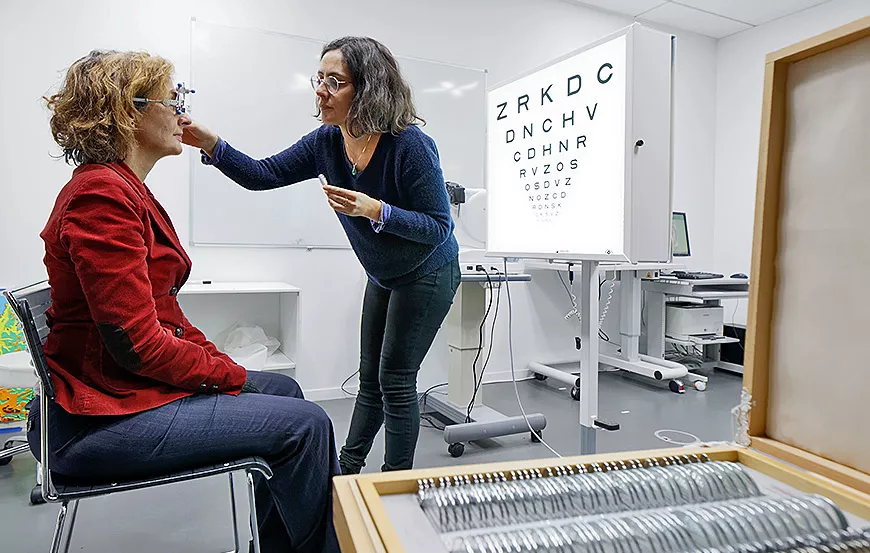Ametropias
Ametropia is the result of a geometric imperfection in the eye, which causes light beams to fail to converge on the retina. This visual disorder causes myopia, hypermetropia, astigmatism and presbyopia.
Definition and symptoms
What is ametropia?
Usually, the image of an object observed by the eye focuses on the retina, which creates a sharp image. But there are focusing defects in the eye that make this image blurry. Ametropias are optical defects of the eye. These are myopia, hyperopia, astigmatism, and with age, presbyopia.
Who can be affected?
Everyone! Whether you are visually impaired or or well-sighted, everyone can be ametropic.
How does it affect you?
A MYOPIC EYE
With myopia, the image is formed in front of the retina. The further away the observed object is, the more blurred the eye sees it (because the further away it is from the retina).

A lens is then needed to shift this image onto the retinal plane and form a sharp image. For a myopic eye, this will be a divergent (or negative power) corrective lens.
Myopia in summary: it’s when distance vision is blurry which requires optical correction, particularly at distance to make vision clear.
A HYPERMETROPIC EYE
In the case of hyperopia, the image is formed behind the retina. The closer the observed object, the more blurred the eye sees it (because the further away it’s from the plane of the retina). A corrective lens is then needed to shift this image onto the retina plane, and form a clear image. For a hyperopic eye, it will be a converging (or positive power) lens.
Hyperopia in summary: it’s when near vision is blurred which requires optical correction, especially near to make vision clear.
ASTIGMATOUS EYE
Astigmatism is an abnormal curvature of the cornea or crystalline lens. When these two elements are spherical (round like a football), there is no astigmatism. But when one or both of these elements are toric (oval like a rugby ball, with a small and a large diameter), there is astigmatism. In the case of astigmatism, the image is formed in front and/or behind the retina, in two different locations.

A corrective lens is then needed to shift this image on the plane of the retina, and form a sharp image. For an astigmatic eye, this will be a lens called “ toric ”. This lens has two different correction powers along two perpendicular axes, corresponding to those of the detected anomaly.
Astigmatism in summary: it’s imprecise vision at different distances which requires optical correction to make vision clear.
- A PRESBYOPIC EYE
Presbyopia is an abnormality of the crystalline lens that occurs naturally with age, from the age of 40. The lens becomes less flexible and is no longer able to focus the rays which pass through it. In the case of presbyopia, the image is formed behind the retina. The closer the observed object, the more blurred the eye sees it (because the further away it is from the plane of the retina).

A special lens is then required to correct this defocus, and thus form a clear image, from an object seen at any distance. This lens must take into account the distance of the object observed, as the crystalline lens no longer focuses. It must therefore correct the image of an object seen at any distance. For presbyopic eyes, we use a multifocal lens, also known as a progressive lens.
Presbyopia in summary: it’s a near vision disorder that appears from the age of 40 and is due to the natural aging of the eye. Presbyopia is corrected in particular by progressive or bifocal lenses.

Correction of ametropia
Ametropia is corrected with glasses or contact lenses. It is then recommended to consult an ophthalmologist to prescribe an optical correction of these various defects. If the person only has ametropia, then once corrected, the eye will be able to have as good vision as someone who does not need glasses.
Understanding your eyeglass prescription
OD : w (- x) à y °
OG : w (- x) à y °
Add : + z
OD: oculus dexter= right eye / OS: oculus sinister= left eye
w : degree of myopia (if preceded by the - sign) or hyperopia (if preceded by the + sign), in diopter
x : degree of astigmatism (+ or -), in diopter
y : axis of astigmatism, in degrees
z : addition: the value that a presbyopic person lacks to see clearly up close, in diopter
It's up to you to explain the following prescription!
OD : -1.00
OG : +0.75 (-1.00)10°
Add : +2.50
Solution: The right eye is myopic by 1 diopter, while the left eye is hypermetropic by 0.75 diopters and astigmatic by 1 diopter. This person is also presbyopic, and needs 2.50 diopters to see clearly at close range
